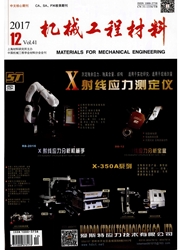

 中文摘要:
中文摘要:
A composite coating containing hexagonal boron nitride(hBN) particles and titanium oxide(TiO2) was formed on the surface of Ti–6Al–4V alloy via micro-arc oxidation(MAO). The effect of quantity of the hBN-particles added into electrolyte on microstructure, composition, and wear behavior of the resulting composite coatings was investigated. Microstructure, phase composition, and tribological behavior of the resulting MAO coatings were evaluated via scanning electron microscopy, X-ray diffraction, and ball-on-disc abrasive tests. The results reveal that the TiO2/hBN composite coating consisting of rutile TiO2, anatase TiO2, and an hBN phase was less porous than particle-free coating. Furthermore, the presence of hBN particles in the MAO coating produced an improved anti-friction property. The composite coating produced in the electrolyte containing 2 g/L of hBN particles exhibited the best wear resistance.The outer loose layer of the MAO coatings was removed by a mechanical polishing process, which led to a significant improvement in the wear resistance and anti-friction properties of the MAO coatings and highlighted an essential lubricating role of hBN particles in the composite coatings. However, wear mechanism of the MAO coatings was not relevant to the presence of hBN particles, where fatigue wear dominated the anti-fraction properties of the MAO coatings with and without hBN particles.
 英文摘要:
英文摘要:
A composite coating containing hexagonal boron nitride(hBN) particles and titanium oxide(TiO_2) was formed on the surface of Ti-6Al-4V alloy via micro-arc oxidation(MAO). The effect of quantity of the hBN-particles added into electrolyte on microstructure, composition, and wear behavior of the resulting composite coatings was investigated. Microstructure, phase composition, and tribological behavior of the resulting MAO coatings were evaluated via scanning electron microscopy, X-ray diffraction, and ball-on-disc abrasive tests. The results reveal that the TiO_2/hBN composite coating consisting of rutile TiO_2, anatase TiO_2, and an hBN phase was less porous than particle-free coating. Furthermore, the presence of hBN particles in the MAO coating produced an improved anti-friction property. The composite coating produced in the electrolyte containing 2 g/L of hBN particles exhibited the best wear resistance.The outer loose layer of the MAO coatings was removed by a mechanical polishing process, which led to a significant improvement in the wear resistance and anti-friction properties of the MAO coatings and highlighted an essential lubricating role of hBN particles in the composite coatings. However, wear mechanism of the MAO coatings was not relevant to the presence of hBN particles, where fatigue wear dominated the anti-fraction properties of the MAO coatings with and without hBN particles.
 同期刊论文项目
同期刊论文项目
 同项目期刊论文
同项目期刊论文
 Tribology behavior of double-glow discharge Mo layers on titanium alloy in aviation kerosene environ
Tribology behavior of double-glow discharge Mo layers on titanium alloy in aviation kerosene environ Finite Element Method Analysis of the Stress for Line Pipe with Corrode Groove During Outdoor Storag
Finite Element Method Analysis of the Stress for Line Pipe with Corrode Groove During Outdoor Storag Application of plasma electrolytic oxidation to the novel aircraft aluminum alloy for enhancing corr
Application of plasma electrolytic oxidation to the novel aircraft aluminum alloy for enhancing corr Effects of prior Corrosion with and without stress on the mechanical properties of 7475-T761 aluminu
Effects of prior Corrosion with and without stress on the mechanical properties of 7475-T761 aluminu Fretting wear and fretting fatigue behaviors of diamond-like carbon and graphite-like carbon films d
Fretting wear and fretting fatigue behaviors of diamond-like carbon and graphite-like carbon films d Beam assisted deposition film for improving fretting fatigue resistance of Ti8Al1Mo1V alloy at eleva
Beam assisted deposition film for improving fretting fatigue resistance of Ti8Al1Mo1V alloy at eleva 期刊信息
期刊信息
